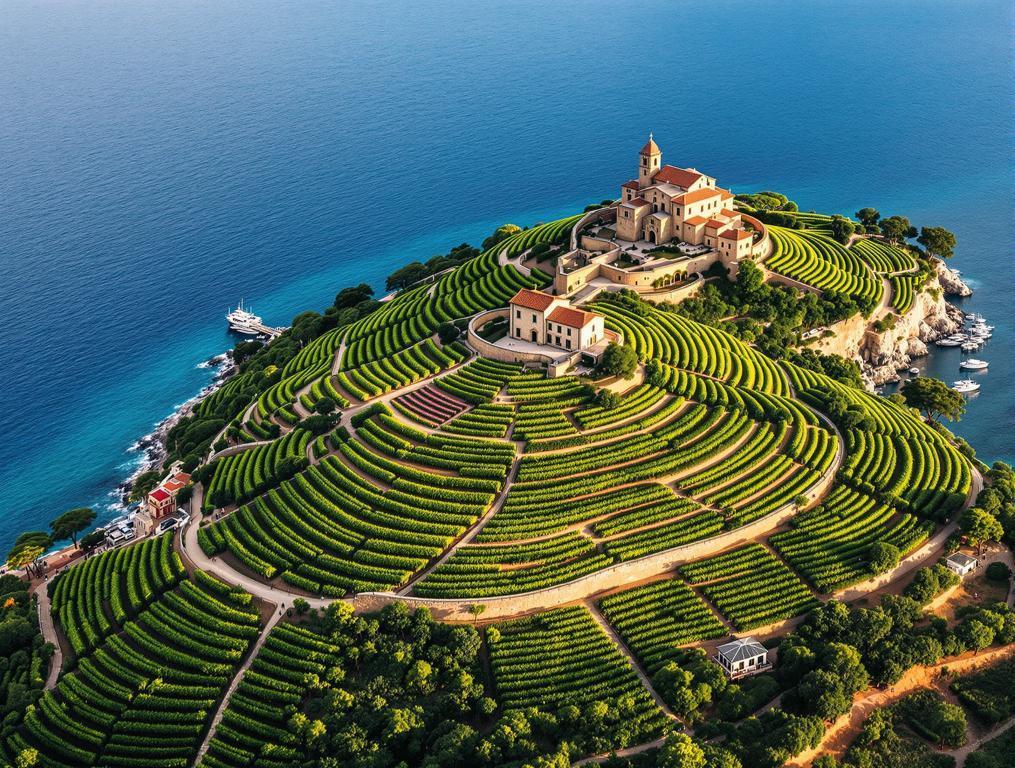The narrow boat cuts through the sapphire Mediterranean waters as I approach the tiny silhouette of Île Saint-Honorat. Just 20 minutes from Cannes’ glittering coastline, I’m heading toward what might be France’s most efficient vineyard. On this 0.35 square kilometer island, a community of 20 Cistercian monks somehow produces 40,000 bottles of premium wine annually from just 8 hectares of vineyards.
The paradox becomes immediately apparent as our ferry docks. How does such a tiny sanctuary—smaller than New York’s Central Park—sustain one of France’s most exclusive wine operations? I’ve come to discover the island’s remarkable efficiency secret that most French Riviera visitors never witness.
Where 20 monks transform 8 hectares into France’s most exclusive island vineyard
Brother Jean-Marie meets me at the fortified monastery entrance, his weathered hands testament to decades of vineyard work. “We use every centimeter,” he explains, gesturing toward terraced rows of vines that seem to squeeze into every available patch of soil not occupied by ancient stone or pine forest.
The production density is staggering. At 5,000 bottles per hectare, these vineyards outperform many in Burgundy’s prestigious Côte d’Or. What makes this even more remarkable is that the entire operation relies on manual cultivation—no mechanical harvesters can access this isolated outpost.
Walking the narrow paths between Syrah and Chardonnay vines (unusual for Provence), I notice something unexpected: pheasants darting between rows. “Our biggest competitors,” Brother Jean-Marie smiles. “They take perhaps 5% of our harvest each year, but we consider it nature’s tithe.”
The monastery’s winemaking follows techniques established over 16 centuries of continuous monastic presence. Founded in 410 AD, the abbey has survived Saracen raids, pirate attacks, and even hosted Saint Patrick as a student before he evangelized Ireland.
While most Provence wineries focus on technological efficiency, the monks’ hyperlocal approach resembles successful models I’ve seen elsewhere, like Minnesota’s hyperlocal food entrepreneurs who maximize output from limited resources.
A wine production density that surpasses Burgundy’s prestigious Côte d’Or vineyards
Unlike the sprawling estates of mainland France, here every grape matters. The monks grow seven grape varieties, including Pinot Noir and Viognier, in soil configurations that would make Burgundian vintners jealous. Their dedication to traditional methods mirrors artisanal approaches found in Kentucky’s craft villages where quality trumps quantity.
The island’s fortified tower, built in the 15th century, now serves as both protection against occasional fierce Mediterranean winds and as a sanctuary for the final stages of wine aging. From its top floor, the entire vineyard operation becomes clear—an intricate mosaic of cultivation squeezed between medieval chapels and craggy coves.
“When you taste their Saint Pierre cuvée, you’re not just tasting wine. You’re experiencing 1,600 years of monastic dedication condensed into a glass. Nowhere else combines such spiritual history with such exceptional terroir.”
This exclusivity comes at a price. The wines sell for €38-65 per bottle, and annual production sells out quickly. While neighboring Cannes hosts millions of tourists annually, this island sanctuary remains delightfully uncrowded, with visitor numbers naturally limited by ferry capacity and the monks’ desire for tranquility.
The island’s beauty rivals that of France’s hidden medieval villages though its artistic legacy remains primarily spiritual rather than visual.
What the guidebooks won’t tell you
To experience Île Saint-Honorat properly, avoid weekend crowds by visiting Tuesday through Thursday. The first ferry departs Cannes at 8:00 AM, and serious visitors should take this one—by afternoon, day-trippers arrive in greater numbers.
Wine tastings occur on the first Friday monthly at 2:30 PM for €25, but require advance booking. For the ultimate experience, time your visit for July when jasmine blooms perfume the air, yet the vineyards remain less crowded than in August.
While inland Provence offers its own charms, as in hidden Provençal villages, Île Saint-Honorat provides a maritime monastery experience just offshore that feels worlds away from the Riviera’s hustle.
As my ferry pulls away, I watch the island shrink against the horizon—this improbable vineyard fortress floating in azure waters. My daughter Emma would call it “the wine island where monks make magic happen.” She’s not far off. In a region famous for excess, I’ve found something rarer: centuries-old efficiency creating extraordinary quality in extraordinarily limited space. Île Saint-Honorat isn’t just a destination; it’s a masterclass in doing more with less, a lesson bottled in wine and preserved by faith.
